-

新人教版高中英语选修2Unit 4 Learning about Language教学设计
This section guides students to pay attention to the typical context of vocabulary use, helps students accumulate vocabulary around the key vocabulary of this unit, and uses the learned words and word chunks in different contexts to deeply understand their meaning and usage, so as to achieve the purpose of review and consolidation.The teaching design activities aim to guide students to pay attention to the typical context in which the target vocabulary is used, as well as the common vocabulary used in collocation, so that students can complete the sentence with correct words. In terms of vocabulary learning strategies, this unit focuses on cultivating students' ability to pay attention to collocation of words and to use word blocks to express meaning.For vocabulary learning, it is not enough just to know the meaning of a single word, but the most important thing is to master the common collocations of words, namely word blocks.Teachers should timely guide students to summarize common vocabulary collocation, such as verb and noun collocation, verb and preposition collocation, preposition and noun collocation, and so on.1. Guide students to understand and consolidate the meaning and usage of the vocabulary in the context, 2. Guide the students to use the unit topic vocabulary in a richer context3. Let the students sort out and accumulate the accumulated vocabulary, establishes the semantic connection between the vocabulary,4. Enable students to understand and master the vocabulary more effectivelyGuiding the Ss to use unit topic words and the sentence patterns in a richer context.

新人教版高中英语选修2Unit 4 Using langauge-Listening教学设计
The theme of the listening section is " talking about scenery and culture along a journey."The part is designed to further lead the students to understand Canadian natural geography and social environment, and integrated into the cultural contrast by mentioning the long train journey from Beijing to Moscow routes. On this basis, the part activates students related travel experience, lets the student serial dialogue, guides the student to explore further the pleasure and meaning of the long journey, and Chinese and foreign cultural comparison.The part also provides a framework for the continuation of the dialogue, which is designed to provide a framework for students to successfully complete their oral expressions, and to incorporate an important trading strategy to end the dialogue naturally.1. Help students to understand and master some common English idioms in the context, and experience the expression effect of English idioms.2. Guide the students to understand the identity of different people in the listening context, and finish the dialogue according to their own experience.3. Instruct the students to use appropriate language to express surprise and curiosity about space and place in the dialogue, and master the oral strategy of ending the dialogue naturally.1. Instruct students to grasp the key information and important details of the dialogue.2. Instruct students to conduct a similar talk on the relevant topic.

新人教版高中英语选修2Unit 5 Learning about Language教学设计
The purpose of this section of vocabulary exercises is to consolidate the key words in the first part of the reading text, let the students write the words according to the English definition, and focus on the detection of the meaning and spelling of the new words. The teaching design includes use English definition to explain words, which is conducive to improving students' interest in vocabulary learning, cultivating their sense of English language and thinking in English, and making students willing to use this method to better grasp the meaning of words, expand their vocabulary, and improve their ability of vocabulary application. Besides, the design offers more context including sentences and short passage for students to practice words flexibly.1. Guide students to understand and consolidate the meaning and usage of the vocabulary in the context, 2. Guide the students to use the unit topic vocabulary in a richer context3. Let the students sort out and accumulate the accumulated vocabulary, establishes the semantic connection between the vocabulary,4. Enable students to understand and master the vocabulary more effectivelyGuiding the Ss to use unit topic words and the sentence patterns in a richer context.Step1: Read the passage about chemical burns and fill in the blanks with the correct forms of the words in the box.

新人教版高中英语选修2Unit 5 Reading and thinking教学设计
The theme of this activity is to learn the first aid knowledge of burns. Burns is common in life, but there are some misunderstandings in manual treatment. This activity provides students with correct first aid methods, so as not to take them for granted in an emergency. This section guides students to analyze the causes of scald and help students avoid such things. From the perspective of text structure and collaborative features, the text is expository. Expository, with explanation as the main way of expression, transmits knowledge and information to readers by analyzing concepts and elaborating examples. This text arranges the information in logical order, clearly presents three parts of the content through the subtitle, accurately describes the causes, types, characteristics and first aid measures of burns, and some paragraphs use topic sentences to summarize the main idea, and the level is very clear.1. Guide students to understand the causes, types, characteristics and first aid methods of burns, through reading2. Enhance students’ ability to deal withburnss and their awareness of burns prevention3. Enable students to improve the ability to judge the types of texts accurately and to master the characteristics and writing techniques of expository texts.Guide students to understand the causes, types, characteristics and first aid methods of burns, through readingStep1: Lead in by discussing the related topic:1. What first-aid techniques do you know of ?CPR; mouth to mouth artificial respiration; the Heimlich Manoeuvre

新人教版高中英语选修2Unit 5 Using langauge-Listening教学设计
The theme of this section is to learn how to make emergency calls. Students should learn how to make emergency calls not only in China, but also in foreign countries in English, so that they can be prepared for future situations outside the home.The emergency telephone number is a vital hotline, which should be the most clear, rapid and effective communication with the acute operator.This section helps students to understand the emergency calls in some countries and the precautions for making emergency calls. Through the study of this section, students can accumulate common expressions and sentence patterns in this context. 1.Help students accumulate emergency telephone numbers in different countries and learn more about first aid2.Guide the students to understand the contents and instructions of the telephone, grasp the characteristics of the emergency telephone and the requirements of the emergency telephone.3.Guide students to understand the first aid instructions of the operators.4.Enable Ss to make simulated emergency calls with their partners in the language they have learned1. Instruct students to grasp the key information and important details of the dialogue.2. Instruct students to conduct a similar talk on the relevant topic.Step1:Look and discuss:Match the pictures below to the medical emergencies, and then discuss the questions in groups.

部编人教版一年级下册识字 《猜字谜》说课稿
这篇课文很简单,而教师在传授这篇课文时的特色就是要在简单之中制造不简单,尝试着在快乐的猜谜语活动中交给孩子们一些规律性的东西,从而让他们在以后的生活和学习中得以运用。二、整体认知课文,学习生字1、自读课文,提问:在自读课文的时候,该注意些什么呢?不要限定学生的思维,引导孩子自主的关注朗读的技巧,并适时的给予指点和引导。2、学习生字。A提问:课文中有一些生字朋友,我们和他们打个招呼吧!(课件亮出生字)B请学生把难度、难认的字多读几遍。——请个别学生当老师,把难读的字和难记的字提选出来,教全班同学读和认记《语文课程标准》指出:语文教学应“注重培养学生自主学习的意识和习惯,为学生创设良好的自主学习情境。”在这一环节中,我将给学生创设一个自主的空间,让孩子自主地根据学生们自身的情况,确定难认和难读的字,把学习的主动权还给孩子。只要合情合理或有独到之处,就给予充分肯定,如果讲得不太合理,教师就给予适时点拨。
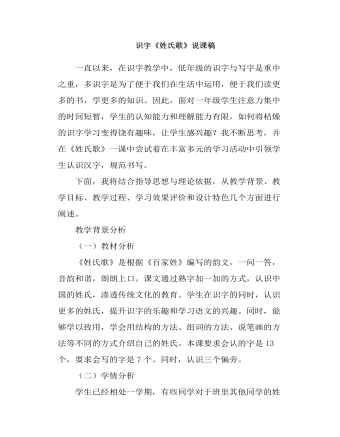
部编人教版一年级下册识字《姓氏歌》说课稿
(一)教材分析 《姓氏歌》是根据《百家姓》编写的韵文,一问一答,音韵和谐,朗朗上口。课文通过熟字加一加的方式,认识中国的姓氏,渗透传统文化的教育。学生在识字的同时,认识更多的姓氏,提升识字的乐趣和学习语文的兴趣。同时,能够学以致用,学会用结构的方法、组词的方法、说笔画的方法等不同的方式介绍自己的姓氏。本课要求会认的字是13个,要求会写的字是7个。同时,认识三个偏旁。 (二)学情分析 学生已经相处一学期,有些同学对于班里其他同学的姓名已经能认识,所以在学《姓氏歌》时,认识同学的姓,介绍自己的姓,这样的内容他们很感兴趣。通过创设丰富多彩的互动活动,引导学生改变被动接受知识的学习方式,在自主学习、主动探究的过程中感受语文学习的乐趣,让学生体验学习的快乐,将习得的方法用于互动交流,不断激发学习动力,真正成为学习的主人。
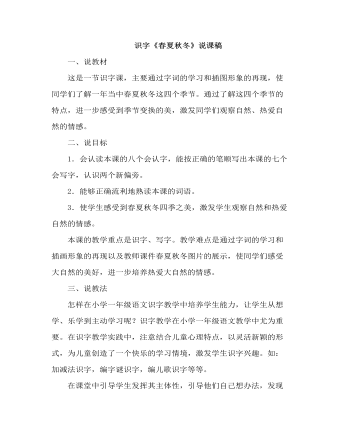
部编人教版一年级下册识字 《春夏秋冬》说课稿
(一)创设情境,揭示课题1.通过课件优美的图片分别展示春、夏、秋、冬四季的美景,请同学回答看到图片想到的是哪个季节,引出课题。 2.板书课题:春夏秋冬。读题。3.学习会写字。理解“春”“冬”是四季中的两个季节,并指导写这两个字。(二)检查预习,引导初读1.自由读课文中的词语,圈划生字,读准字音。2.以小组为单位,讨论会写字的巧记方法。(三)重点品读,理解感悟1.感悟春夏秋冬四季。(1)教师领读词语“春飞吹、下雨落、秋霜降、冬雪飘”。教师课件展示四季美景。(2)学生感悟四季之美。(3)教师引导学生通过春、夏、秋、冬还能分别联想哪些景物和现象。(4)学生自己组织句子,用通顺的语言描述自己喜欢的季节和美景。

部编人教版一年级下册识字《猜字谜》(说课稿)
【说教材】我今天说课的内容是部编小学语文第二册《猜字谜》。这是两则猜字的谜语。生动有趣,语言优美,读起来朗朗上口。猜谜语寓知识性、趣闻性、哲理性于一体,能使学生主动参与,积极开动脑筋。结合本课、本单元的特点,以及《新课标》对知识与能力、过程与方法、情感态度与价值观三个纬度的要求,制定了以下3个学习目标:1.认识“相、遇”等12个生字。会写“字、右”等7个字。 2.朗读谜语,边读边想,总结猜谜语的好方法。3.培养学生收集谜语和自编谜语的兴趣。【说教法、学法】基于对教学目标、教材的分析,结合新课标的相关理念,我采用了自读感悟、自主探究、合作交流、实践创新等学习方式,努力构建开放而又有活力的新型语文课堂,始终把学生放在学习主人的地位,而教师则是学生学习的同行者、伙伴。 根据一年级学生的形象思维比较强、求知欲望强、对能激起他们的兴趣的东西感触深的特点,,我采用了情景教学、问题探究、直观教学等方法开展教学。
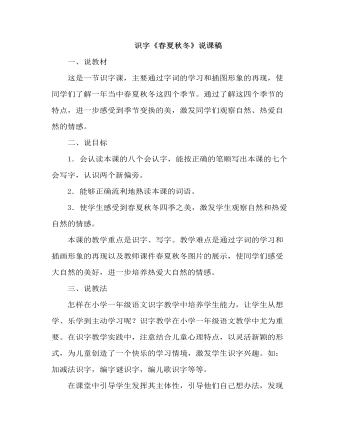
部编人教版一年级下册识字《春夏秋冬》(说课稿)
四、说过程为完成本课的教学目标,我设计了以下几个教学环节。(一)创设情境,揭示课题1.通过课件优美的图片分别展示春、夏、秋、冬四季的美景,请同学回答看到图片想到的是哪个季节,引出课题。2.板书课题:春夏秋冬。读题。3.学习会写字。理解“春”“冬”是四季中的两个季节,并指导写这两个字。(二)检查预习,引导初读1.自由读课文中的词语,圈划生字,读准字音。2.以小组为单位,讨论会写字的巧记方法。(三)重点品读,理解感悟1.感悟春夏秋冬四季。(1)教师领读词语“春飞吹、下雨落、秋霜降、冬雪飘”。教师课件展示四季美景。(2)学生感悟四季之美。(3)教师引导学生通过春、夏、秋、冬还能分别联想哪些景物和现象。(4)学生自己组织句子,用通顺的语言描述自己喜欢的季节和美景。
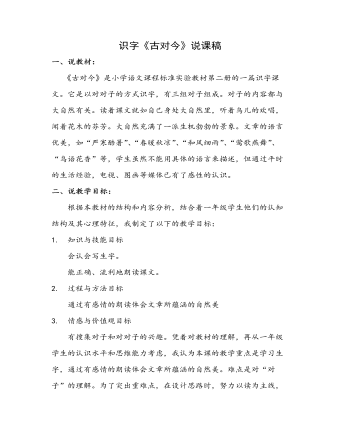
部编人教版一年级下册识字 《古对今》说课稿
三、说教法考虑到一年级学生的现状,我主要采取设置情景教学法,让学生积极主动地参与到教学活动中来,使他们在活动中得到认识和体验,产生践行的愿望。培养学生将课堂教学和自己的经验结合起来,引导学生主动去发现周边的客观事物。基于本课题的特点,我主要采用了以下的教学方法:直观演示法:利用图片等手段进行直观演示,激发学生的学习兴趣,活跃课堂气氛,促进学生对知识的掌握。四、说学法在整堂课教学,让学生在声情并茂的朗读中感受文本的美,早读中识字,在读中感悟,在读中积累、内化,在读中训练语言,来培养学生的朗读能力,表演能力也拓展了学生的思维能力,还培养了学生的自信心和主动探索、团结合作、勇于创新的精神。激发他们的情感,让他们在自主,合作,探究中学习语文,从中感受到学习语文的乐趣,更喜欢学习语文。五、说教学过程在这节课的教学过程中,我注重突出重点,条理清晰,紧凑合理,各项活动的安排也注重互动、交流,最大限度的调动学生参与课堂的积极性、主动性。
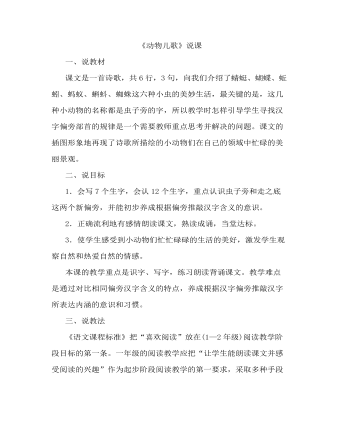
部编人教版一年级下册识字《动物儿歌》(说课稿)
一、说教材课文是一首诗歌,共6行,3句,向我们介绍了蜻蜓、蝴蝶、蚯蚓、蚂蚁、蝌蚪、蜘蛛这六种小虫的美妙生活,最关键的是,这几种小动物的名称都是虫子旁的字,所以教学时怎样引导学生寻找汉字偏旁部首的规律是一个需要教师重点思考并解决的问题。课文的插图形象地再现了诗歌所描绘的小动物们在自己的领域中忙碌的美丽景观。二、说目标1.会写7个生字,会认12个生字,重点认识虫子旁和走之底这两个新偏旁,并能初步养成根据偏旁推敲汉字含义的意识。2.正确流利地有感情朗读课文,熟读成诵,当堂达标。3.使学生感受到小动物们忙忙碌碌的生活的美好,激发学生观察自然和热爱自然的情感。本课的教学重点是识字、写字,练习朗读背诵课文。教学难点是通过对比相同偏旁汉字含义的特点,养成根据汉字偏旁推敲汉字所表达内涵的意识和习惯。
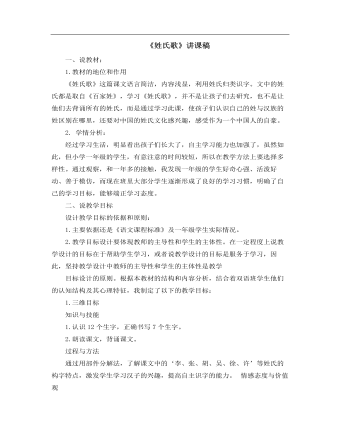
部编人教版一年级下册识字《姓氏歌》(说课稿)
一、说教材;1.教材的地位和作用《姓氏歌》这篇课文语言简洁,内容浅显,利用姓氏归类识字。文中的姓氏都是取自《百家姓》,学习《姓氏歌》,并不是让孩子们去研究,也不是让他们去背诵所有的姓氏,而是通过学习此课,使孩子们认识自己的姓与汉族的姓区别在哪里,还要对中国的姓氏文化感兴趣,感受作为一个中国人的自豪。2. 学情分析:经过学习生活,明显看出孩子们长大了,自主学习能力也加强了,虽然如此,但小学一年级的学生,有意注意的时间较短,所以在教学方法上要选择多样性。通过观察,和一年多的接触,我发现一年级的学生好奇心强、活泼好动、善于模仿,而现在班里大部分学生逐渐形成了良好的学习习惯,明确了自己的学习目标,能够端正学习态度。
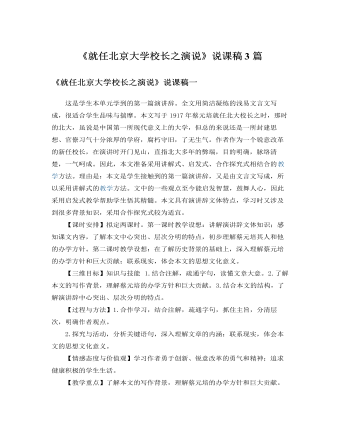
人教版高中语文必修2《就任北京大学校长之演说》说课稿3篇
(三)教学重、难点1、教学重点:结合课文,了解演讲辞针对性强、条理清楚、通俗易懂、适当的感情色彩等特点。2、教学难点:深入理解文章内涵,联系现实,体会本文的现实意义二、说学情高中学生在初中阶段已经接触过演讲辞了,对演讲词的特点已经有了一些基本的知识,因此本轮的教学应该让他们在此基础上有所提高。本文是学生在高中阶段第一次接触演讲辞,有必要让他们了解演讲辞的特点及课文如何体现这些特点的。随着年龄的增长,生活阅历的增加,高中学生正逐渐形成自己对世界、对人生的看法,蔡元培先生的这篇文章能很好地激发他们对当前的高中学习和未来的大学生活进行思考。此外,学生对北大的历史及蔡元培先生作这番演讲的时代背景了解不深,应作出补充说明。
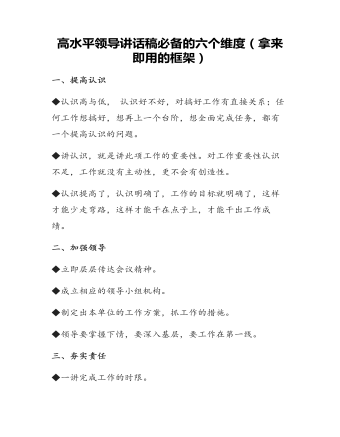
高水平领导讲话稿必备的六个维度(拿来即用的框架)
三、夯实责任◆一讲完成工作的时限。◆二讲工作任务要层层分解,落实责任。◆三讲工作中要齐心协力,上下联动,相互配合。◆四讲工作要分步推进,稳步实施。◆五讲要注意解决工作中出现的问题,要创造性地开展工作。
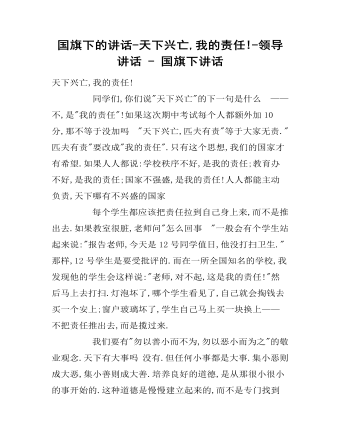
国旗下的讲话-天下兴亡,我的责任!-领导讲话 - 国旗下讲话
天下兴亡,我的责任! 同学们,你们说"天下兴亡"的下一句是什么 ——不,是"我的责任"!如果这次期中考试每个人都额外加10分,那不等于没加吗 "天下兴亡,匹夫有责"等于大家无责."匹夫有责"要改成"我的责任".只有这个思想,我们的国家才有希望.如果人人都说:学校秩序不好,是我的责任;教育办不好,是我的责任;国家不强盛,是我的责任!人人都能主动负责,天下哪有不兴盛的国家每个学生都应该把责任拉到自己身上来,而不是推出去.如果教室很脏,老师问"怎么回事 "一般会有个学生站起来说:"报告老师,今天是12号同学值日,他没打扫卫生."那样,12号学生是要受批评的.而在一所全国知名的学校,我发现他的学生会这样说:"老师,对不起,这是我的责任!"然后马上去打扫.灯泡坏了,哪个学生看见了,自己就会掏钱去买一个安上;窗户玻璃坏了,学生自己马上买一块换上——不把责任推出去,而是揽过来.我们要有"勿以善小而不为,勿以恶小而为之"的敬业观念.天下有大事吗 没有.但任何小事都是大事.集小恶则成大恶,集小善则成大善.培养良好的道德,是从那很小很小的事开始的.这种道德是慢慢建立起来的,而不是专门找到大事才干.天下无大事,请先把自己脚下的纸屑捡起来——这就是我们要做的事.
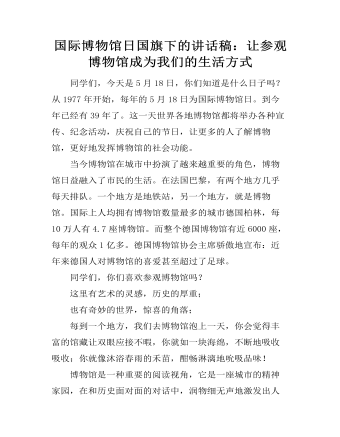
国际博物馆日国旗下的讲话稿:让参观博物馆成为我们的生活方式
同学们,今天是5月18日,你们知道是什么日子吗?从1977年开始,每年的5月18日为国际博物馆日。到今年已经有39年了。这一天世界各地博物馆都将举办各种宣传、纪念活动,庆祝自己的节日,让更多的人了解博物馆,更好地发挥博物馆的社会功能。当今博物馆在城市中扮演了越来越重要的角色,博物馆日益融入了市民的生活。在法国巴黎,有两个地方几乎每天排队。一个地方是地铁站,另一个地方,就是博物馆。国际上人均拥有博物馆数量最多的城市德国柏林,每10万人有4.7座博物馆。而整个德国博物馆有近6000座,每年的观众1亿多。德国博物馆协会主席骄傲地宣布:近年来德国人对博物馆的喜爱甚至超过了足球。同学们,你们喜欢参观博物馆吗?这里有艺术的灵感,历史的厚重;也有奇妙的世界,惊喜的角落;
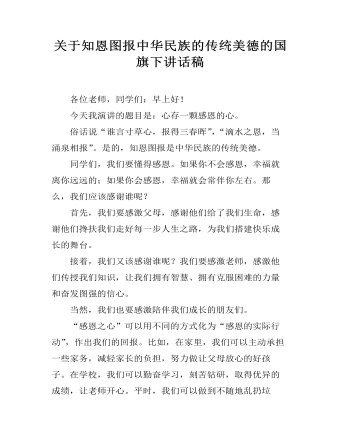
关于知恩图报中华民族的传统美德的国旗下讲话稿
各位老师,同学们:早上好!今天我演讲的题目是:心存一颗感恩的心。俗话说“谁言寸草心,报得三春晖”,“滴水之恩,当涌泉相报”。是的,知恩图报是中华民族的传统美德。同学们,我们要懂得感恩。如果你不会感恩,幸福就离你远远的;如果你会感恩,幸福就会常伴你左右。那么,我们应该感谢谁呢?首先,我们要感激父母,感谢他们给了我们生命,感谢他们搀扶我们走好每一步人生之路,为我们搭建快乐成长的舞台。接着,我们又该感谢谁呢?我们要感激老师,感激他们传授我们知识,让我们拥有智慧、拥有克服困难的力量和奋发图强的信心。当然,我们也要感激陪伴我们成长的朋友们。
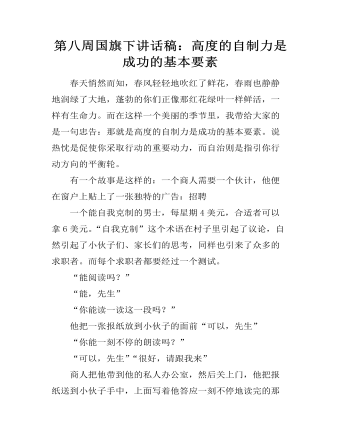
第八周国旗下讲话稿:高度的自制力是成功的基本要素
春天悄然而知,春风轻轻地吹红了鲜花,春雨也静静地润绿了大地,蓬勃的你们正像那红花绿叶一样鲜活,一样有生命力。而在这样一个美丽的季节里,我带给大家的是一句忠告:那就是高度的自制力是成功的基本要素。说热忱是促使你采取行动的重要动力,而自治则是指引你行动方向的平衡轮。有一个故事是这样的:一个商人需要一个伙计,他便在窗户上贴上了一张独特的广告:招聘一个能自我克制的男士,每星期4美元,合适者可以拿6美元。“自我克制”这个术语在村子里引起了议论,自然引起了小伙子们、家长们的思考,同样也引来了众多的求职者。而每个求职者都要经过一个测试。“能阅读吗?”“能,先生”“你能读一读这一段吗?”他把一张报纸放到小伙子的面前“可以,先生”“你能一刻不停的朗读吗?”“可以,先生”“很好,请跟我来”商人把他带到他的私人办公室,然后关上门,他把报纸送到小伙子手中,上面写着他答应一刻不停地读完的那段话,阅读刚开始,商人就放出六只可爱的小狗,小狗跑到男孩的脚边,“这太过分了”男孩经受不住诱惑,要看看美丽的小狗,由于视线离开了阅读的材料,男孩忘记了自己的角色,读错了,当然他也就失去了这个机会。
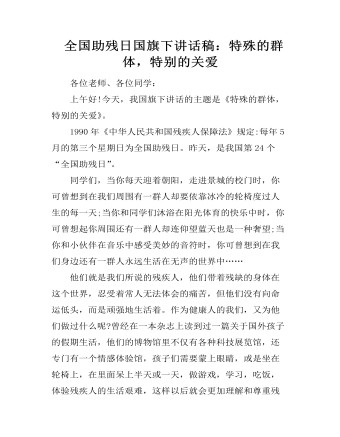
全国助残日国旗下讲话稿:特殊的群体,特别的关爱
各位老师、各位同学:上午好!今天,我国旗下讲话的主题是《特殊的群体,特别的关爱》。1990年《中华人民共和国残疾人保障法》规定:每年5月的第三个星期日为全国助残日。昨天,是我国第24个“全国助残日”。同学们,当你每天迎着朝阳,走进景城的校门时,你可曾想到在我们周围有一群人却要依靠冰冷的轮椅度过人生的每一天;当你和同学们沐浴在阳光体育的快乐中时,你可曾想起你周围还有一群人却连仰望蓝天也是一种奢望;当你和小伙伴在音乐中感受美妙的音符时,你可曾想到在我们身边还有一群人永远生活在无声的世界中……他们就是我们所说的残疾人,他们带着残缺的身体在这个世界,忍受着常人无法体会的痛苦,但他们没有向命运低头,而是顽强地生活着。作为健康人的我们,又为他们做过什么呢?曾经在一本杂志上读到过一篇关于国外孩子的假期生活,他们的博物馆里不仅有各种科技展览馆,还专门有一个情感体验馆,孩子们需要蒙上眼睛,或是坐在轮椅上,在里面呆上半天或一天,做游戏,学习,吃饭,体验残疾人的生活艰难,这样以后就会更加理解和尊重残疾人。

